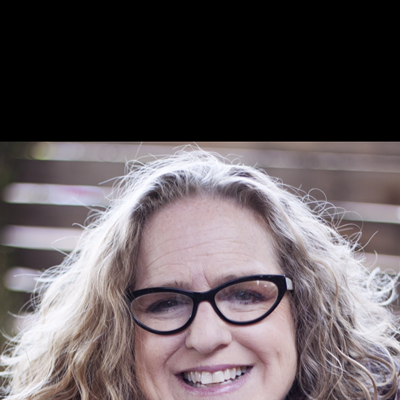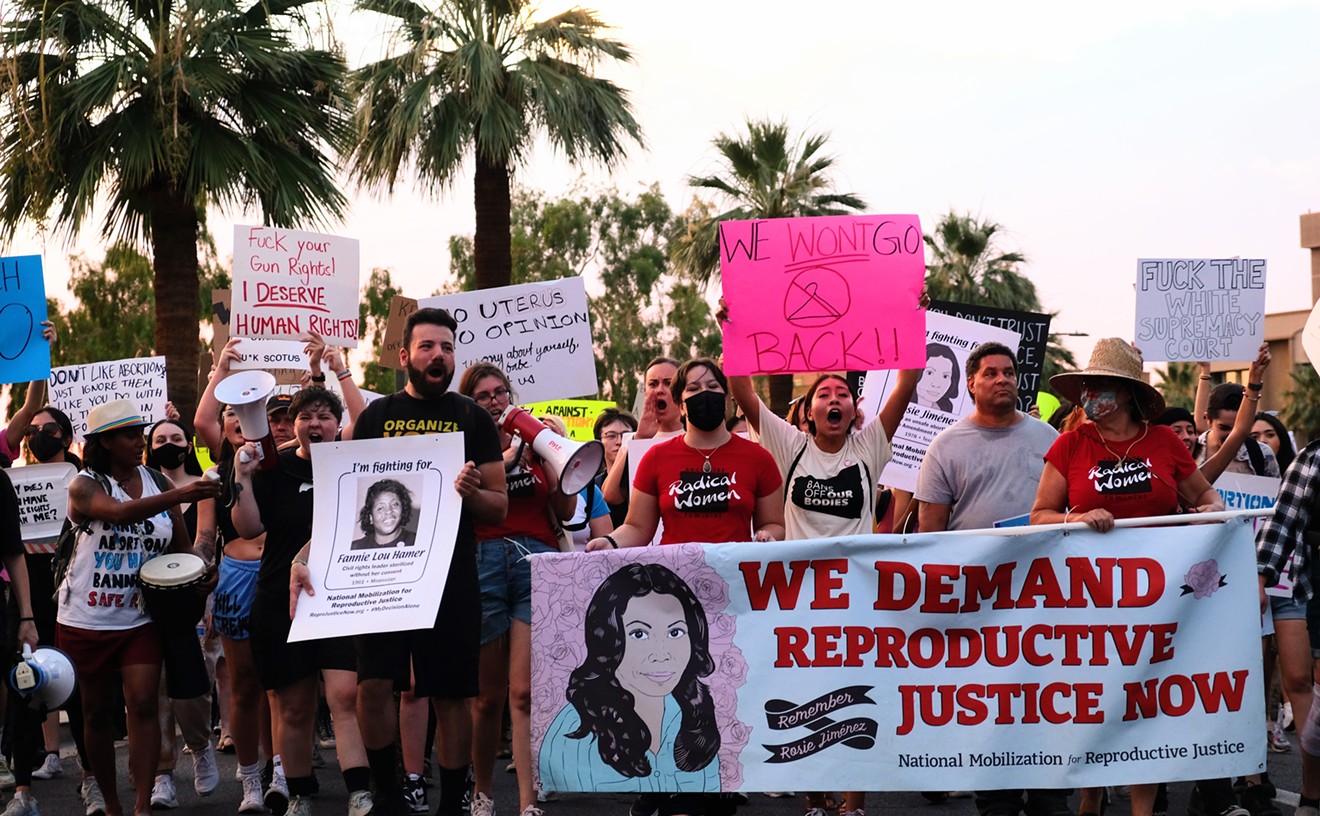The details of juvenile cases aren't public, but according to someone close to her, she threatened family members and then a judge; that's how she ended up at the Arizona Department of Juvenile Corrections.
She clearly requires constant supervision, but on September 21, staff at the ADJC's Black Canyon facility in Phoenix left the girl alone in a bathroom for at least eight minutes. When a guard finally asked what was taking so long, the girl replied that she was constipated. She emerged from the stall covered in blood and deep cuts she'd made on both arms with a piece of a broken light bulb, then ran through the grounds "with blood squirting everywhere," according to the agency's internal documents.
"It was like CSI meets like a horror movie," one eyewitness tells New Times, adding that some of the cuts "were so bad, to where you could almost see the meat in them."
The girl was handcuffed and taken to a local hospital, where she refused treatment. On the way back to the agency, she bit a staff member who tried to make her wear a seatbelt.
It took two days to clean up the mess in the bathroom.
• On February 14, a boy at the Adobe Mountain facility in Phoenix was found in his room unconscious with a pair of pants tied around his neck. Staff loosened the pants, and the boy gasped for air; later, he admitted he'd had a Valentine's Day fight on the phone with his girlfriend before trying to kill himself. • On April 3, staff at Black Canyon noticed a girl lying on the floor; another kid admitted she knew the girl was trying to choke herself. A guard cut a ripped T-shirt from around the neck of the girl, who had covered the evidence with a towel after taking a shower. • On April 4, a boy at the Catalina facility in Tucson jammed his door shut, and it was only when another kid begged a guard to check on him that any adult noticed that the boy was turning red and then blue, with a towel wrapped around his feet and neck to choke himself. Staff eventually kicked down the door and cut the towel off with a knife.The guards seemed surprised, even though it had been discovered earlier that day that the boy was already making a rope; he was angry that he couldn't make a phone call when he wanted to.
• On May 17, a boy at Adobe Mountain claimed he fell and hit his head, causing a bloody injury, but another kid admitted to guards that the boy had purposely smashed his skull into a metal bar on his bunk bed. Guards then found a bloody staple that the boy had been using to cut his thigh. When he was escorted away, the boy announced, "You haven't seen nothing yet!" asking, "You wanna see blood?"The guards put the boy in solitary confinement, removed his clothes, and gave him what's called a "suicide suit" to wear. He refused, and stood undressed, hitting his wound and punching the wall with his fist, 'til staff calmed him down.
• Staples are a popular cutting implement for kids at the ADJC. On April 14, staff found that a girl at Black Canyon had hidden a staple under her upper lip. She admitted she'd hidden other staples around her housing unit, and showed them where. She'd also used lead from a pencil to carve into her skin, and showed them where she'd hidden that, too. She told staff she'd made a drawing in science class she was proud of; in it, she's hanging herself.The staff counseled the girl "about setting goals for herself to keep herself motivated," according to the agency's report on the incident.
"Youth replied, 'If I make a goal for myself it would be to kill myself.'"
The Arizona Department of Juvenile Corrections is supposed to educate and rehabilitate juvenile delinquents. Instead, the agency has become the state's adolescent mental hospital, a job it's clearly not equipped to handle.
Things are literally a bloody mess. Staff find screws, nails, and broken pencils in kids' rooms. But self-abuse gets more creative. One boy recently bit off his entire fingernail in front of a guard. A girl in solitary confinement was so desperate to hurt herself that she was seen rubbing her wrist against the rough paint on the floor hard enough to draw blood. The kids are sometimes put into suicide suits so they won't try to hang themselves with their shirts or pants, but the Velcro on the suits presents a challenge; you can draw blood with that, too.
For some kids, the cutting and suicidal talk is almost certainly copycat behavior. But every suicide threat is supposed to be taken seriously. And some kids arrive very sick.
On April 24, a boy arrived at Adobe Mountain. Here's an excerpt from his intake report:
Youth states he was hearing voices and crying. Youth indicated he had been hearing voices for quite some time and instructed him to kill himself. On Tuesday 04/21/09 youth jumped off a second floor balcony at the direction of his voices . . . Youth further indicated he has asked his father for medications the other day and his father had refused and would not take him for medical assistance. Youth was attempting to get to a hospital for assistance when he was arrested. Youth was informed by his cousin that he had burglarized a home without any memory of the incident. He appears to be suffering from some type of psychosis and needs to be closely watched and evaluated ASAP for medications.
For this story, New Times reviewed hundreds of pages of agency reports on suicidal behavior, threats, and injuries, obtained through a public-records request. Other reports — such as the one involving the girl who ran through the grounds of Black Canyon, dripping blood — were obtained from sources inside the agency. About a half-dozen current ADJC employees from three of the agency's four facilities were interviewed extensively, some over the course of several months. In almost all cases, names of youth were redacted from reports; New Times will not name any youth in this story, or the employees, who fear for their jobs.
New Times examined six months' worth of reports of suicidal behavior at the ADJC in 2009, and the incidents mentioned in this story only scratch the surface of what is clearly a gaping wound. The agency has documented cases of kids self-abusing by cutting, scratching, choking, and hitting themselves on pretty much a daily basis.
It's hard to know exactly what's going on, and how it compares nationally, without formal statistic-gathering. An organization called Performance Based Standards does just that on a host of issues, including suicidal behavior, for participating juvenile corrections facilities across the country. The Arizona Department of Juvenile Corrections participated in PBS in the past but hasn't for years. (Department administrators say it's not cost-effective to take part in the national comparison; the ADJC uses its own system to measure data, which they say is more precise.)
National and local experts on mental-health care for teens were interviewed for this story. The general consensus is that services are sorely lacking, both in the private and public sectors, as well as at correctional facilities. To further complicate matters: Once a child is sent to the correctional system, legally, the public health system will no longer cover mental healthcare.
Problems appear to be particularly serious in Arizona, but the state is far from alone. Parents everywhere are at a real loss as to how to help their kids.
Earlier stories in this series explored one family's successful attempt to place their son in a government-paid residential treatment facility that can address his serious mental illness and violent tendencies ("Saving Alex," October 8) and another family's less-successful efforts to save their daughter from substance abuse and mental illness by sending her to a private wilderness-therapy camp ("Losing Erica," November 5).
The truth is that both Alex Varlotta and Erica Harvey could easily have ended up at the Arizona Department of Juvenile Corrections. The department estimates that 30 percent of the children in its care suffer from serious mental illness, with a diagnosis falling under the rubric of the DSM-IV, the American Psychiatric Association's official manual of mental disorders. Even more have suicidal tendencies, and about 84 percent of all the children at the ADJC have a substance abuse problem.
While conditions have improved somewhat at the ADJC, following a federal investigation several years ago, the agency is clearly unable to provide adequate care for seriously mentally ill kids. And yet it is the agency's legal mandate to take these kids.
"We have to be responsible for what comes through the door," says Kellie Warren, the ADJC's deputy director in charge of mental-health services.
"It's not an appropriate place for these kids," she admits. "Those kids that are significantly mentally ill, they end up decompensating here."
And yet, Warren acknowledges, this is where they land — at an increasing rate. "You're seeing the justice system becoming almost the new asylums," she says.
She's not exaggerating. The state recently closed the adolescent unit at the Arizona State Hospital. Maricopa County has no comparable unit for adolescents at its own facility. If you qualify for Medicaid, you can get your mentally ill kid services — maybe. If you don't qualify for Medicaid, the private options are even more limited. If your kid is violent, services may be all but non-existent.
Warren says juvenile court judges hear of the compendium of services her agency provides (and she certainly does a good sales job on it, if her interview with New Times is any indication), and they figure it's the best option for the mentally ill kids who come through their courtrooms.
Even that option could go away.
This summer, Governor Jan Brewer asked state agencies to submit a plan describing how they would cut 15 percent of their budget over a six-month period. The ADJC's plan includes closing three of its four facilities, as well as its mental-health unit for boys. It's widely believed that the plans the governor asked for are designed to be a scare tactic for the Arizona Legislature, which is eager to avoid raising taxes — but you never know.
"I don't even want to think it's a reality, to tell you the truth," Warren says. Don't worry, she adds after a pause, clearly imagining a painful scenario. "We're just not going to open the gates and let everyone out."
The Department of Juvenile Corrections is a state agency most Arizonans have never heard of.
It's not typically a headline-making department. The state's most violent juvenile offenders go to the adult system; most kids wind up at the ADJC after committing a series of petty crimes. In October 2008, only 126 of the 625 kids in custody were there for violent crimes.
The agency's mandate is to rehabilitate, not punish. These are, after all, children. Their records are kept secret and expunged once they turn 18.
You may not have known of it, but the U.S. Department of Justice is well aware of the ADJC. Twice now, the state agency has fallen under scrutiny and federal orders to improve services and ensure safety.
The 1987 civil rights lawsuit Johnson v. Upchurch ultimately led to federally mandated changes at the agency, which had famously kept one boy in solitary confinement for several weeks.
Conditions for kids behind bars in Arizona got better — for a while. Then they got worse.
In 2001, the Department of Justice began making inquiries into conditions at the ADJC, after a series of stories in New Times revealed concerns about the safety of both staff and kids, as well as potential civil rights violations. In 2002 and 2003, three boys in ADJC custody committed suicide. The DOJ ultimately investigated under CRIPA, the Civil Rights of Institutionalized Persons Act, confirming much of what New Times had originally reported.
Again, things got better, though internal critics have always wondered just how much. The Department of Justice was satisfied, however, and closed its case in 2007.
No one from the outside has paid much attention since. And even when they have, it's tough to figure out just how closely anyone's looking. This fall, the Arizona Auditor General released a report on suicide prevention at the ADJC. The report was largely glowing, leading the Arizona Republic, the state's newspaper of record, to hand out high-fives in a story headlined, "Arizona's Juvenile Jails Free of Suicides Since '03."
The story and the audit didn't mention how close some of the calls were, even though the report acknowledged reviewing agency documents from March to May 2009; presumably, those would have included several of the incidents mentioned above.
The audit also praised the department for improving staff/youth relations, while ignoring three recent criminal cases in which ADJC staff were sentenced to probation after pleading guilty to having sexual relationships with kids.
And perhaps auditors failed to interview the staff members New Times spoke with, all of whom presented grave concerns about conditions at the ADJC — while insisting they like their jobs and want to continue working with kids who desperately need them.
The employees' concerns vary from person to person, with an overriding theme: This agency — charged with taking care of sometimes violent and mentally disturbed kids — is not very professional.
The ADJC employees warn that a public-records request will reveal only some of what's going on at the agency.
"All someone has to do is write an IR [incident report] and put 'confidential' on it," and it's kept secret, one guard says. (To the agency's credit, many of the records provided by the ADJC for this story are, in fact, quite damning.)
A tour of the facilities is pointless, too, another guard says — even for the federal investigators, who were treated to a whitewash, several of the employees say.
"Anytime anybody comes to do an inspection, we know months in advance," one comments. It's easy to make things look good.
Another, who has worked for the ADJC since the Upchurch case, sees a real change in the kids coming into the system today.
"The kids we have now are nothing like the kids we had in those days," he says. "The kids we had then were real criminals."
He adds, "I wish we had counselors for every single one of them, and then I wouldn't have a job . . . We have psych associates that are overly taxed. Usually at any given point and time we'll have three psych associates to deal with 100 kids."
As for the community-based care that the agency is pushing for, which results in early release, the employee says, "Those kids come right back."
Norman Davis, chief presiding judge for the juvenile division of the Maricopa County Superior Court, echoes this.
"The first year I thought I was saving everybody. The second year, all the kids came back," he says, laughing ruefully and adding that obviously this is an exaggeration.
As for the extent to which mental illness affects the behaviors of the kids he sentences, Davis says he's really not sure.
"The longer I go — mental illness, what does that mean, exactly?" he asks, rhetorically. "Things of the mind are very difficult to get ahold of."
One shared concern among those interviewed for this story is staffing numbers. The CRIPA investigators strongly suggested that in many cases, each housing unit needs to have two staff members on hand at all times — including at night. And yet that tends to be a time, staff say, when corners are cut.
An escape attempt last year could have been avoided, had staffing levels been adequate, some say. The incident is not about suicidal behavior per se, but it does speak to the issue of lack of supervision. And this happened well before current funding cuts were in place.
At 11:30 p.m. on September 4, 2008, four boys were found running on a field at the Adobe Mountain facility; they were using their shoes and shirts to try to pull down razor wire and escape when they were caught. It was later revealed that two of the boys had hidden near a bathroom, hit a guard in the back of the head with a soap sock (a sock with a bar of soap in it), dragged him into a room, tied him up with pieces of shirt and towel, and taken his keys and radio.
One staff member in particular, who happens to work at Adobe Mountain, was very concerned.
"The staff that got assaulted, he was working by himself with 32 youth," the source says. "There could have been somebody there to help the staff call security right away."
(ADJC administration acknowledge that there was, in fact, just one staff member assigned to that housing unit at the time of that incident. The agency "strives" to increase staffing, it says, and uses "rovers" from its security department to attempt to fill in gaps.)
The employee is concerned because he sees staff coddle youth — and he wonders what the staff are getting in exchange. He sees staff bring kids food in exchange for being good.
"I don't see bringing someone a carne asada burrito just for cleaning his room up for a week," he says.
But apparently staffing numbers have been good enough to afford some free time to certain ADJC employees who have provided favors to kids far greater than the occasional carne asada treat.
Daneen Clora Carter, an ADJC employee, was charged with having sexual intercourse and oral sex with a boy in custody at Adobe Mountain in August 2007. She is now on probation.
Stephanie Motzer, a teacher with the ADJC, is on probation after having sex in 2007 with a boy who had recently been released from the facility.
And Ciara Portwood, an ADJC employee, is on probation for having sex with a boy now on parole. He is the father of her child, due to have been born by now.
ADJC's response: "Every incident of sexual behavior involving staff and youth is unacceptable . . . That said, the fact that the employees about whom you have inquired were caught and prosecuted reflects the effectiveness of awareness and detection efforts directed towards sexual misconduct."
None of the women are currently employed by the ADJC. The Maricopa County Attorney's Office declined to allow Erin Otis — who prosecuted the three cases and possibly additional ones — to comment.
Employees believe under-training is a big problem at the AJDC.
"You just have to have a high school diploma — and be breathing," one employee says of the process it takes to become a guard, called a Youth Corrections Officer.
There is training in suicide prevention (there didn't used to be much, if any, before the CRIPA investigation), but the employee says it's not enough to prepare a guard to cut a ligature off the neck of a kid — something this employee has had to do.
Since the successful suicide attempts years ago, the facilities have been suicide-proofed. But there's no way to do it completely, the employee says.
"The new thing now is the light bulbs. Nobody thought anything about light bulbs."
(The department says it's reviewing its light bulb use to see about making them harder to remove.)
Of course, if you have good supervision, something like that doesn't matter. ADJC administration says the employee who failed to look in on the girl who slashed herself with a broken light bulb was disciplined, and staff at all four of its facilities were reminded to closely observe troubled kids.
Number-wise, supervision is getting worse, not better; budget cuts this summer have had a big impact, the employee says.
"They're changing ratios to make sure the least amount of staff is there. So instead of having a ratio of 1 to 8, they're going to be 1 staff to like 12 kids."
That, the employee says, could have influenced what happened with the girl who cut herself in September.
The employee says the girl has been at the facility since about June, and should be on closer supervision. The staff coddle her to keep her calm, the employee adds.
"The only reason I think she's alive right now is because they give her what she wants. They allow her to sleep in class. They allow her to sleep in groups. She needs to be medicated. She needs to be somewhere where she can be forced to be medicated. She's just one of those kids that we can't help."
The employee, who watched the videotape that, for privacy reasons, only shows the girl walking into the bathroom stall and emerging almost 10 minutes later, says, "I don't know if the staff didn't know she was in there, or they were so busy dealing with other kids [and] they knew she was in there but couldn't get over there . . . It's kind of an unwritten rule that if a kid's on [close observation], and they're in the bathroom, you usually check on them every couple minutes.
"It's probably the worst thing I've seen since I've been there," the employee says.
And yet, the ADJC is likely the only place this girl is going to get any help at all. The employee who knows her says she's estranged from her family, as so many kids in custody are.
For some, it's not such a bad life at a place like Black Canyon, the employee says.
"The kids say it's like day camp here. They get to watch movies and they get to have parties. There's a couple church volunteers that adopt the cottages . . . And every month they come in and do a birthday party."
No, the kids can't open their bedroom doors or go to the bathroom any time they want. But "they know they're going to have a roof over their head. They know they're not going to get abused. They know they're going to get three meals a day."
It would be nice to think that if the ADJC does empty most of its beds, community-based services will be waiting to fill the gap. The employee is skeptical.
What if Black Canyon really does close? What will happen to that girl? The employee shrugs.
"They'll probably just let her out."











